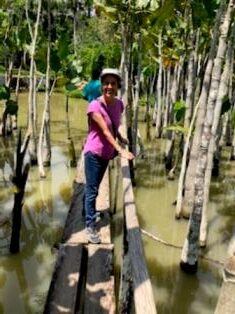This is the second of two posts about my visit to Peru’s Amazon region. As I mentioned in my previous post, when my husband and I traveled there with our friends Ruth and Alan, we flew into the large city of Iquitos, which is unreachable by road. If you go to that region, you see why: the waters of the Amazon River and its myriad tributaries flood through hopelessly dense vegetation. Overland travel doesn’t work there. The river is the road. Though the river divides the land, it is what connects the people.
We stayed at Sinchicuy Lodge. This video shows the lodge at its spiffed-up best. What you have to picture, though, is that the lodge truly is in a jungle. Galoshes are kept on hand for guests to foray into the mud. There is no hot water, so you take cold showers. (But the weather is so hot you hardly care.) Everywhere, you watch out for spiders and bugs. But this is a small price to pay for seeing this vast stunning river and the ecosystem that depends on it.
Piranhas
One morning our guide took us fishing for piranhas. I’m not sure what we would have done if we’d caught a big one. We caught a number of little ones we didn’t keep, and our guide helped us unhook them. Take a look at the teeth, and you’ll see why it has to be done carefully. (As an interesting side story, our son Brendan once went fishing in the Brazilian Amazon with a local fisherman. They caught some good-sized piranhas. Just to show Brendan what those nasty teeth can do, the fisherman picked up a piranha by the tail and dangled it just above the rim of the wooden boat. The fish’s clacking teeth bit a hole in it!)

The Yagua
Indigenous peoples live in the Peruvian Amazon region. Most have pretty much assimilated and speak Spanish rather than their traditional language. However, some effort has been made for Amazonian children to learn at least a little of their region’s indigenous language in school. Our guide took us to visit a few members of the Yagua tribe, who had put on native costumes made of grass. They led us through one of their traditional dances and showed us how to use their blow gun. Although the Yagua keep these traditions alive, the people certainly don’t isolate themselves from the outside world. Ruth saw one of the young people with a cell phone.
For the Future
Our guide, a young local man with indigenous roots, had a real love for the ecology of the area. He took us on a muddy hike into the forest and showed us this old tree, astonishing in its size. The perimeter of the trunk at its base is probably larger than my living room. Later our guide gathered us together on the grounds of the lodge. Together we planted a tree that he said was good for the environment because of the way it uses water. There was already so much water and so many trees I had to wonder how much difference we were making! But I appreciated his love for the Amazonian forest.
Our guide then told us a saying: To give to the future, do three things: Plant a tree, have a child, and write a book. Ruth and I looked at each other and smiled. We’d already done all three.








Yes, this was a fabulous trip, and also challenging! I am so thankful that we went together with you and Rory. I was impressed by the wonder of this area, the dense forests, the gigantic Amazon river that serpentines everywhere, the friendly and ambitious people, and the immense variety of animals, some scary! In the animal reserve, an anaconda, sloth, monkeys, and birds–all was thrilling! One of the hardest things for me was the oppressive heat, especially on the jungle walk. But the open river helps to cool things down. What an amazing experience!
Ruth, I agree. It was incredible. For me, the most amazing thing was the river itself, so huge and beautiful. So glad we shared this trip!
Connie,
I enjoyed reading about this adventure so much – would love to hear more.
My last big trip was to Iceland, an incredible experience. This sounds like a trip quite “the opposite”, considering the climate, wet lands, etc. I don’t know if I will ever get there, but would like to. Will you be writing a book about these people?
Jo, how exciting to go to Iceland! Yes, the Amazon region is so different from anything in northern climates, especially a place like Iceland. Being in the Amazon rain forest can be physically difficult because the heat is just so intense. But I’m really glad I saw it. There’s nothing like that incredible river.
As for my writing, at this point I’m still working on another novel set in Hungary. But you’re not the first person who’s asked me if I plan to write about Peru. For now, no, I’m not planning on that. But sometimes plans change . . .